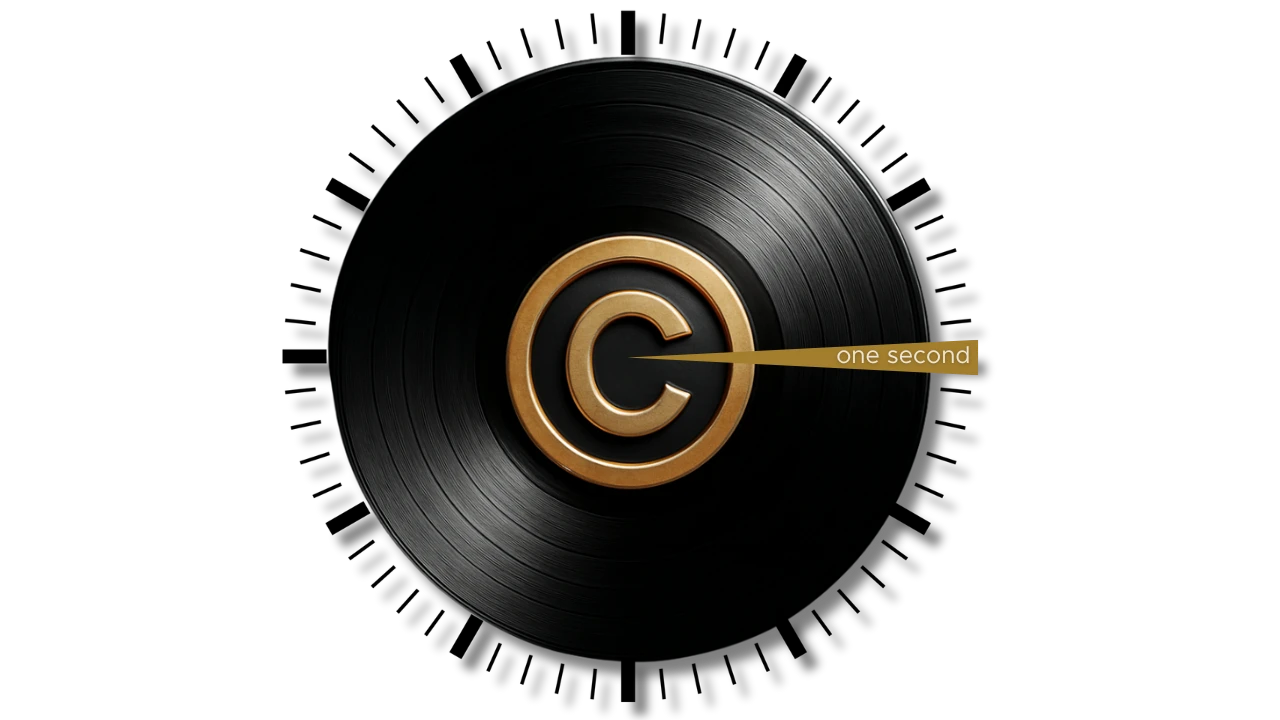Introduction
In the bustling arena of contemporary advertising, brevity is often seen as the soul of wit, and increasingly, the cornerstone of commercial impact. Budweiser, a global beverage giant, recently leveraged this principle with its “One-Second Ads” campaign. This ingenious marketing strategy presented viewers with fleeting musical snippets, challenging them to identify the underlying song. Yet, this creative endeavor, underpinned by a public declaration of “zero dollars spent on music rights,” has uncorked a potent legal debate, revealing the intricate challenges posed by digital sampling and the ever-evolving boundaries of copyright law.
The central legal conundrum at play is whether such ephemeral musical fragments—mere flickers of sound—can trigger copyright infringement, particularly when strategically deployed for commercial gain. This exploration navigates the labyrinthine definitions of originality, the protectability of micro-samples, and the contentious issue of market substitution, drawing insights from diverse legal traditions across the United States, the European Union, and India. The core question facing intellectual property jurisprudence today is discerning when strategic brevity crosses the line from innovative engagement into unauthorized appropriation.
Dissecting the “Work”: Beyond Auditory Recognition
A prevailing instinct in the discourse surrounding Budweiser’s campaign is the belief that if a sound fragment is immediately recognizable, it must inherently be a copyrighted work. However, the legal framework for intellectual property protection operates on a more nuanced principle: originality, not mere association, forms the bedrock of copyright. The human ear’s capacity to identify a familiar beat or an iconic timbre does not automatically imbue that sound with the legal attributes of original authorship.
This critical distinction becomes starkly apparent when examining the global criteria for originality. Across jurisdictions, a convergent standard emerges: legal protection is extended only to creations that embody a deliberate, creative act, rather than those that simply exist or are widely disseminated. For instance, the Supreme Court of India, in Eastern Book Company v. D.B. Modak1, articulated that a work must demonstrate “skill, labour and capital.” Similarly, the United States Supreme Court, in Feist Publications, Inc. v. Rural Telephone Service Co2., mandated a “modicum of creativity,” a low but essential bar. Concurrently, the European Union’s Infopaq International A/S v. Danske Dagblades Forening test3 emphasizes “the author’s own intellectual creation.” These benchmarks collectively underscore that copyright safeguards ingenuity and artistic expression, not simply the widespread familiarity of a sound.
Consider the nature of many one-second clips featured in the Budweiser campaign: the sharp attack of a snare drum from a Nirvana recording, a fleeting piano chord from an Elton John composition, or a subtle, inhaled vocal preceding a Beyoncé lyric. These isolated moments, while undeniably recognizable—a deliberate design choice for an advertisement built on guessability—often lack independent musical structure or expressive content. They are sonic shards, cleaved from larger, meticulously composed musical works. For a fragment to attain the autonomous status of a “work” worthy of copyright protection, it must transcend mere familiarity; it must be demonstrably structured to reflect a unique artistic choice. Copyright, fundamentally, is a shield for creativity, not a registry of public recognition.
The intrinsic elements of musical composition—melody, harmony, and rhythm—are pivotal in this assessment. A melody unfolds over time, creating a sequence of notes that can be hummed or recalled. Harmony imbues a song with emotional depth, contrasting cheerful major chords with melancholic minors. Rhythm, the very pulse of music, provides energy and movement. These interwoven elements transform raw sound into structured music and unequivocally signify authorship. A one-second clip is typically too compressed to establish any of these foundational elements. While it might resonate due to its provenance from a celebrated song, it frequently lacks the standalone expressive features that copyright law is designed to protect. The legal distinction parallels the difference between recalling a single word from a famous poem versus reciting an entire stanza: one evokes the work, the other recreates its creative core.
The Shadow of Commercial Intent: Beyond De Minimis
Despite the primary emphasis on independent originality, judicial considerations have, in certain contexts, acknowledged the role of recognizability. This factor frequently emerges when assessing whether a fragment was purposefully extracted from a known source to commercially exploit its familiarity. Here, recognizability intersects with an analysis of commercial intent and potential market impact.
Jurisprudence across various legal systems illustrates the diverging approaches to this complex issue. In the United States, the Sixth Circuit’s decision in Bridgeport Music, Inc. v. Dimension Films4 famously adopted an uncompromising stance regarding sound recordings: any unauthorized use, even a mere fraction of a second, was deemed automatically infringing. The court’s unequivocal pronouncement, “Get a license or do not sample,” sent a chilling message, though this rigid interpretation was specifically applied to sound recordings, not underlying musical compositions, and subsequently faced considerable academic critique.
This absolutist position was later nuanced by the Ninth Circuit’s ruling in VMG Salsoul, LLC v. Madonna Louise Ciccone5. In this case, Madonna’s producers had sampled a 0.23-second horn hit from another song for her track “Vogue.” Moving away from Bridgeport’s strict literalism, the court reinstated the necessity of “meaningful similarity,” questioning whether the sample was perceptible and expressively significant enough to warrant legal action. This decision implicitly invoked the principle of de minimis non curat lex – that the law does not concern itself with trifles – suggesting that truly negligible uses might not meet the threshold for infringement, though the VMG Salsoul ruling itself did not explicitly define a de minimis standard for sound recordings.
Across the Atlantic, the Court of Justice of the European Union (CJEU), in Pelham GmbH v. Hasso Knopp6 (the Kraftwerk case), sought a more tailored balance. It held that even very short samples could infringe the rights of a phonogram producer if they were recognizable and had not been transformed in a way that rendered them unrecognizable. Crucially, this ruling was grounded in “related rights” for phonograms, distinct from the copyright in the underlying musical works, highlighting a critical legal distinction often overlooked.
Indian law, as defined under Section 2(p) of the Copyright Act, encompasses “musical work” as consisting of music, including graphical notation, but explicitly excludes accompanying words or actions. Indian courts have further clarified that for a sound to qualify as a musical work, it must not only involve melody or harmony but also be fixed in a tangible form. In Super Cassettes Industries Ltd. v. Hamar Television Network (India TV) Private Limited7, the Delhi High Court considered whether short musical clips used in news broadcasting possessed sufficient originality and expressiveness. These judgments suggest that under Indian law, a musical segment must possess not only fixation and authorship but also adequate expressive content to qualify as a protectable work, with recognizability serving as one of several supporting factors, while the nuances surrounding musical sampling remain a fertile area for judicial interpretation.
Regardless of their specific jurisdictional approaches, these cases collectively underscore a vital point: the commercial exploitation of a clip, irrespective of its brevity, if it is both recognizable and untransformed, may still constitute infringement. This is not solely due to its duration, but rather its inherent expressive value, auditory distinctiveness, or its strategic function within a commercial context. This nuanced perspective offers a more structured legal stance, circumnavigating the “slippery slope” of arbitrary length thresholds for infringement. Thus, even brief clips, particularly when artfully woven together for a cumulative branding effect, are not automatically shielded from legal challenge solely due to their brevity.
The Broader Contours: Sound-Alikes and the Licensing Economy
Budweiser’s “One-Second Ads” presents a fascinating case study within the broader landscape of copyright challenges in the digital age. The campaign, which essentially stitches together recognizable, micro-samples, poses questions that extend beyond direct sampling. Consider the phenomenon of “sound-alikes” – musical works that deliberately mimic the distinctive style, instrumentation, or melodic structure of another, without directly sampling the original recording. While not a direct component of the Budweiser case, these instances highlight the difficulty in defining the boundaries of appropriation when the “spirit” of a work is evoked without literal copying. Courts have, in some instances, found infringement in such cases by applying tests of “substantial similarity,” even in the absence of direct copying.
Furthermore, the explosion of digital audio workstations and ubiquitous access to vast libraries of music have democratized sound manipulation. This technological ease, however, has outpaced the clarity of legal definitions, creating fertile ground for disputes. The economic implications for rights holders are also significant. A robust music licensing ecosystem exists precisely to compensate creators for the use of their intellectual property. When a company publicly boasts of bypassing this system, it not only impacts individual artists and labels but also undermines the very economic model that supports creative output. While the “optics” of Budweiser’s campaign – openly touting “zero dollars spent on music rights” – might invite judicial scrutiny, it’s crucial to distinguish between perceived opportunism and actual legal infringement. Copyright law’s purpose is to protect expression, not to police commercial motives.
Ultimately, the Budweiser “One-Second Ads” serve as a potent reminder of the evolving challenges facing copyright law in the era of micro-content. While many of the isolated fragments used in the campaign may not meet the stringent legal threshold for originality on their own, their deliberate compilation for commercial gain, coupled with their undeniable recognizability, tests the very spirit of the licensing system. The enduring legal inquiry must remain rooted in objective standards of protectable expression, ensuring that innovation is fostered without eroding the fundamental rights of creators to control and profit from their original works. The echoes of these one-second ads will likely resonate in courtrooms for some time, shaping the future of digital sampling and advertising in an increasingly sonically saturated world.
The Unfolding Harmony: Navigating Copyright’s Future in a Fragmented Soundscape
The Budweiser “One-Second Ads” campaign, while ingenious in its simplicity, casts a long shadow over the contemporary legal landscape of intellectual property. It starkly illuminates the increasing tension between technological capability and legal precedent, revealing how rapidly evolving creative practices can outpace the traditional definitions of copyrightable “works.” As digital tools continue to democratize sound manipulation, allowing for the effortless isolation and recontextualization of sonic fragments, similar controversies are almost inevitable. Imagine, for instance, a future advertising campaign built not on musical snippets, but on micro-clips of famous movie dialogue—a single, iconic gasp from a thriller, or a distinctive laugh from a comedy, each lasting less than a second, yet instantly recognizable. Would such fleeting vocalizations, stripped of their original narrative context, attract the same legal scrutiny as musical fragments, or would they too fall into a grey area where recognizability clashes with the stringent demands of originality?
The ramifications of such cases extend far beyond individual brand campaigns, impacting the very ecosystem of creative compensation. If the threshold for protection is consistently set too high for micro-samples, it could inadvertently devalue the granular components of artistic works, discouraging licensing and potentially undermining the economic livelihood of creators who rely on royalties from their compositions and recordings. Conversely, an overly broad interpretation of infringement, where mere recognition triggers liability regardless of originality, risks stifling innovation and chilling creative expression. This delicate balance demands a forward-thinking approach that acknowledges both the legal rights of creators and the dynamic nature of contemporary artistic and commercial endeavors. Courts and policymakers must grapple with how to effectively apply principles forged in an analog era to a digital reality where “bits and bytes” of creativity are endlessly recombined and repurposed.
As we peer into the future, the Budweiser case serves as a poignant overture to an unfolding legal symphony. Will the coming years see a global convergence on a clearer de minimis standard for musical fragments, or will divergent national laws lead to a fractured and unpredictable landscape for digital sampling? Perhaps the most pressing question that lingers is this: as artificial intelligence gains the capacity to generate highly realistic “sound-alike” compositions, or even to synthesize “original” micro-samples from vast databases of existing music, will the very concept of “authorship” itself become a second-long enigma, prompting a fundamental re-evaluation of who, or what, holds the rights to a fleeting note in the digital age? The answers to these questions will profoundly shape not only the future of advertising but the very fabric of intellectual property law.
Citations
- Eastern Book Company v. D.B. Modak AIR 2008 SUPREME COURT 809
- VMG Salsoul, LLC v. Madonna Louise Ciccone No. 13-57104 (9th Cir. 2016)
- International A/S v. Danske Dagblades Forening test ECLI:EU:C:2009:465
- Bridgeport Music, Inc. v. Dimension FilmsNo. 13-57104 (9th Cir. 2016)
- VMG Salsoul, LLC v. Madonna Louise Ciccone No. 13-57104 (9th Cir. 2016)
- Pelham GmbH v. Hasso Knopp No. 13-57104 (9th Cir. 2016)
- Super Cassettes Industries Ltd. v. Hamar Television Network (India TV) Private Limited CS(OS) 1889/2009
Expositor(s): Adv. Anuja Pandit






